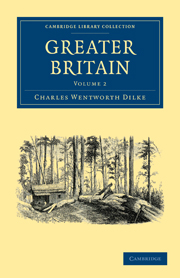Book contents
- Frontmatter
- Contents
- LIST OF ILLUSTRATIONS
- PART III
- PART IV
- CHAP. I MARITIME CEYLON
- CHAP. II KANDY
- CHAP. III MADRAS TO CALCUTTA
- CHAP. IV BENARES
- CHAP. V CASTE
- CHAP. VI MOHAMEDAN CITIES
- CHAP. VII SIMLA
- CHAP. VIII COLONIZATION
- CHAP. IX THE “GAZETTE”
- CHAP. X UMRITSUR
- CHAP. XI LAHORE
- CHAP. XII OUR INDIAN ARMY
- CHAP. XIII RUSSIA
- CHAP. XIV NATIVE STATES
- CHAP. XV SCINDE
- CHAP. XVI OVERLAND EOUTES
- CHAP. XVII BOMBAY
- CHAP. XVIII THE MOHURRUM
- CHAP. XIX ENGLISH LEARNING
- CHAP. XX INDIA
- CHAP. XXI DEPENDENCIES
- CHAP. XXII FRANCE IN THE EAST
- CHAP. XXIII THE ENGLISH
- INDEX
- Plate section
CHAP. VI - MOHAMEDAN CITIES
Published online by Cambridge University Press: 29 August 2010
- Frontmatter
- Contents
- LIST OF ILLUSTRATIONS
- PART III
- PART IV
- CHAP. I MARITIME CEYLON
- CHAP. II KANDY
- CHAP. III MADRAS TO CALCUTTA
- CHAP. IV BENARES
- CHAP. V CASTE
- CHAP. VI MOHAMEDAN CITIES
- CHAP. VII SIMLA
- CHAP. VIII COLONIZATION
- CHAP. IX THE “GAZETTE”
- CHAP. X UMRITSUR
- CHAP. XI LAHORE
- CHAP. XII OUR INDIAN ARMY
- CHAP. XIII RUSSIA
- CHAP. XIV NATIVE STATES
- CHAP. XV SCINDE
- CHAP. XVI OVERLAND EOUTES
- CHAP. XVII BOMBAY
- CHAP. XVIII THE MOHURRUM
- CHAP. XIX ENGLISH LEARNING
- CHAP. XX INDIA
- CHAP. XXI DEPENDENCIES
- CHAP. XXII FRANCE IN THE EAST
- CHAP. XXIII THE ENGLISH
- INDEX
- Plate section
Summary
Through Mirzapore, Allahabad, and Futtehpore, I passed on to Cawnpore, spending but little time at Allahabad; for though the city is strategically important, there is in it but little to be seen. Like all spots of the confluence of rivers, Allahabad is sacred with the Hindoos, for it stands, they say, at the meeting-point of no less than three great streams—the Ganges, the Jumna, and a river of the spiritland. To us poor pagans, the third stream is invisible; not so to the faithful. Catching a glimpse of Marochetti's statue at the Cawnpore well, as I hurried through that city, I diverged from the East Indian Railway, and took dawk-carriage to Lucknow.
As compared with other Indian cities, the capital of Oude is a town to be seen in driving rather than in walking; the general effects are superior in charm and beauty to the details, and the vast size of the city makes mere sight-seeing a work of difficulty. More populous before 1857 than either Calcutta or Bombay, it is still twice as large as Liverpool. Not only, however, is Lucknow the most perfect of the modern or Italianised Oriental towns, but there are in it several buildings that have each the charm of an architecture special to itself. Of these, the Martinière is the most singular, and it looks like what it is—the freak of a wealthy madman.
- Type
- Chapter
- Information
- Greater Britain , pp. 221 - 233Publisher: Cambridge University PressPrint publication year: 2009First published in: 1868



